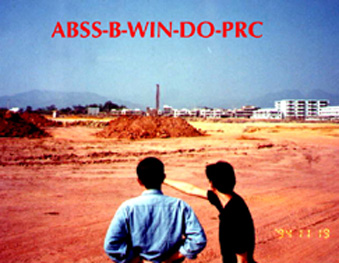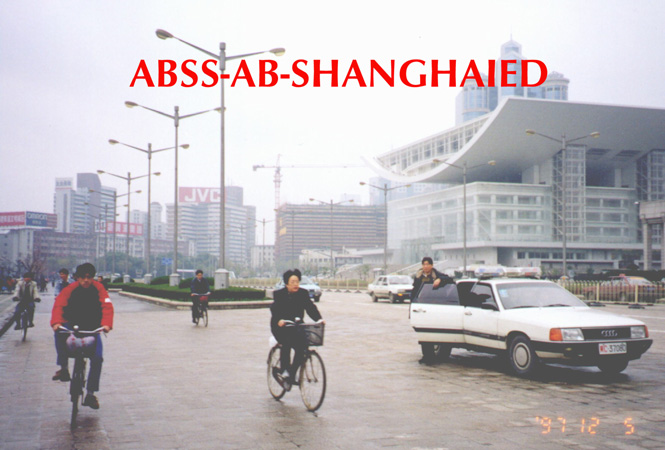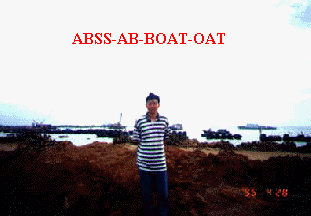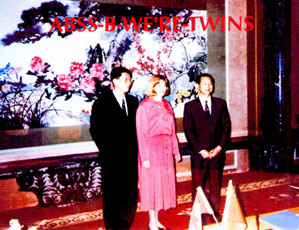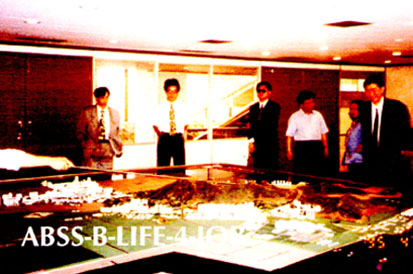|
ABSS-AB-H2O-EAST 1998 On top of a reservoir at Mieyuan ('Cloudy'
)Township, the water is at
the opposite side of the barrier I was standing on, 1993. The incident happened during one of our usual swimming sessions and this time I found myself exhausted and struggling to get back to shore. A classmate called 'Yam' was nearby and helped me up. I was so glad that I made it onshore and once I got out of the water, I started laughing. Yam thought I was pretending to be in trouble, immediately he pushed me right back in the water. And it was not until they noticed that this time I was
'really' in trouble then several of my schoolmates helped me back onshore. Ever since then I had actually developed a phobia in swimming. In order to ensure ample water supply, the then Hong Kong government under the British administration decided to purchase water from China. We call these water supplies, 'The Water of the East River'. Part of an ongoing art project initiated in 1980 entitled ABSS 1980- .
|
||
|
ABSS-B-WIN-DO-0PRC 1998
At a remote town in Guangdong Province, PRC.1994. They pulled out their pistols and couple iron clubs hidden under the seats. I guess their action had said it all. Part of an ongoing art project initiated in 1980 entitled ABSS 1980- . |
||
|
ABSS-AB-SHANGHAIED 1998 City of Shanghai, 1997.It is not uncommon for state owned companies in PRC to summon police cruisers to chauffer foreign guests around town. I guess the purpose is to show their hospitality; but I imagine it's also a mean to impress their guests. Part of an ongoing art project initiated in 1980 entitled ABSS 1980- . |
||
|
ABSS-AB-BOAT-OAT 1998 At the shore of South Sea, Tanhai, Shantou, Guangdong,
PRC, 1995. When I was growing up in Hong Kong, it seemed like all my associations with China were with water. I remember there was a family friend we called Uncle Sit, occasionally he would go back to China to visit his relatives. Like many Chinese in Hong Kong with relatives in China, they would bring suitcases (or rather, large canvas bags) of clothing and other commodities for their relatives when they return to China. I remembered once seeing Uncle Sit cut open a bar of soap, and there was a watch with stainless steel metal bend hidden in it. He told me he planned to sell the watch in China, but he could not find a buyer. I guess, besides subsidizing his relatives with clothing and other necessities; he was trying to do some business during the trip. In Cantonese, we call this type of merchandises ‘Water Goods". We also have heard many stories about people ‘swam' from China to Hong Kong to pursuit brighter future; some became residents of Hong Kong, many had perished in sea. During the ‘Cultural Revolution'in the 60’s, I was always haunted by graphic images on newspaper of bound corpses found at Hong Kong water and shores. These were corpses of apparent victims of the
Cultural Revolution.They
were dumped into the South Sea in China and gradually made their ways
into the Hong Kong harbor. Part of an ongoing and still ongoing art project initiated in 1980 entitled ABSS 1980- .
|
||
|
ABSS-AB-HK-1997, 1998
Tsim Sha Tsui East, Hong
Back in the
60’s, this area was a British army compound nicknamed Tai-Pow-Mike
(Big Sack of Rice). We used to sneak in for fishing and did other
juvenile pranks, such as riding the bicycle into the harbor. Part of an ongoing and still ongoing art project initiated in 1980 entitled ABSS 1980- .
|
||
|
ABSS-B-WE'RE-TWINS 1998 City of Shantou, Guangdong, PRC, June 1996. With the Mayor of The City of Saint John, New Brunswick, Canada and an official of The City of Shantou, PRC. After the ceremony of signing a letter of intent to twin both cities. Although Shantpu is a southern coastal city and one of the Five Special Economic Zones in China, however, due to the central government's strategy for economic reform, it was the last of the SEZ being developed intensively. Such that in 1996, there were still very few westerners in the city comparing to major cities, such as Shanghai and Beijing. I was being told that some of the locals actually thought the Mayor of Saint John was the Queen of England ( probably because of the color of her hair). I also discovered that although Saint John has a population of about 120,000 and Shantou has a population of more than 4,000,000; however there are many similarities between both cities. Such as, both Saint John and Shantou are coastal cities located at the south-eastern part of their respective countries. On the municipal maps, not only they show that both cities are divided by a waterway in similar shapes at the general area of their central district, by coincidences, their downtown cores, airports, universities and a major parkland are all located at the similar area on their respective maps. On the maps, the two cities are practically 'identical twins'. I guess God sometimes does work in his mysterious ways. Part of an ongoing art project initiated in 1980 entitled ABSS 1980- .
|
||
|
ABSS-B-LIFE-4-JOB 1998 Nanyau District, Shanzhen Special Economic Zone, PRC, April, 1995. This evening, while we were having dinner at a local restaurant, we were being told that on the highway we just used, shortly after we passed-by, two out-of-province young female laborers working in a local factory were killed while trying to cross the highway. In some parts of China, it is common to see pedestrians crossing highways with traffics rushing-by in speeds exceeding 120 km/hr. Part of an ongoing art project initiated in 1980 entitled ABSS 1980- . |
